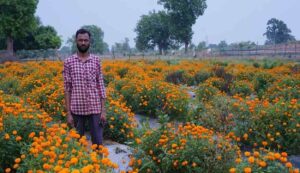Success Story: This farmer from Chhattisgarh earned a huge amount of Rs 15-20 lakh annually from flower cultivation
Success Story: Moti Lal Banjara comes from a farming family and lives in the Pathalgaon block of Jashpur district, Chhattisgarh. His father and grandparents farmed traditional crops for decades, mostly for their personal use, such as pulses, groundnuts, and rice. For them, farming was a way of life rather than a profitable commercial endeavor. Moti, like a lot of young people in rural India, was supposed to go to school and look for a steady career.

But his goals went a different course. His goal was to modernize and mechanize ancient agricultural methods in order to turn agriculture into a lucrative industry. After completing his studies until the 12th grade, Moti Lal came to the realization that, with the correct information and techniques, farming might reach its full potential. He started going to the Krishi Vigyan Kendra (KVK) close to his village on a daily basis because he was determined to improve his family’s farming methods.
He was able to interact with agricultural specialists during these excursions and learn about the newest farming methods and technology. He first became aware of marigold cultivation—a novel and exciting prospect—during one of these excursions. He was intrigued by the great demand for marigold flowers, especially during holiday seasons, and he viewed it as a way to make farming a profitable enterprise.
Change to Floriculture
In 2014, Moti Lal started cultivating marigolds, although only on a seasonal basis. For celebrations like Ganesh Chaturthi and Diwali, he was growing flowers. Although flower growing was a seasonal enterprise, the results were good. His income from farming was never consistent. For four years, he continued to do this while gradually learning about floriculture.
In 2018, KVK scientists introduced him to new agricultural techniques, including mulching and drip irrigation. These methods produced better crops, maximized water utilization, and reduced labor costs. He was happy with the results, so he decided to produce marigolds all year round instead of just during certain festivals. It changed the game. His steady supply of flowers allowed him to have continual access to the market. As a consequence, the revenue was steady and substantial.
Increased Profitability and High Yield
Currently, Moti Lal sets aside at least one acre of land for the year-round cultivation of marigolds. Better agricultural techniques have resulted in a huge rise in his produce. He mostly grows two types of marigold: Kolkatti and Laddu. He also cultivated gladiolus of the Aruna kind. These types’ vivid color and lengthy shelf life make them highly valued on the market.
He has observed that five acres of rice cultivation yield less than one acre of marigold production. Conventional crops yield little and require months to develop. Unlike conventional crops, floriculture yields high returns quickly since it takes less time to harvest. During the last Diwali season, he made almost Rs 3 lakh in 15 days from a single acre of marigolds. He repeats the harvests three or four times a year to guarantee the flow of cash since each crop lasts around four to five months.
He presently cultivates flowers on three acres, bringing in between Rs 15 and Rs 20 lakh a year. To increase his flower yield, he also grows yellow gladiolus in addition to marigolds. In addition to floriculture for his own use, he maintains a small kitchen garden with veggies including okra, tomatoes, and chili. He makes between Rs 10,000 and Rs 15,000 more as a result.
Market Success and Investment
Moti Lal is mostly due to careful preparation and financial investment in high-quality agricultural production. To ensure the plants develop healthily, he purchases high-quality marigold seedlings from nurseries. His planting strategy maintains enough plant spacing for healthy development and aeration. In order to provide the finest care for his farm’s plants, he has also used soil testing techniques to determine the right nutrients.
Wholesale merchants are its main source of customers. He sells straight to merchants during their busiest festival season in order to make the most money. Because of its greater yield and market demand, the Laddu kind of marigold is the top money generator.
Future Plans and Sustainable Practices
Moti Lal supports sustainable agriculture. He no longer does chemical farming. In order to keep pests away from his flowers, he uses organic insecticides instead of harmful ones. In addition to benefiting the environment, this increases the appeal of his flowers to consumers who want flowers that are cultivated organically.
Water conservation is yet another essential component of his farming. By adopting drip irrigation, he has effectively reduced water loss while maximizing supply to his crops. It has been particularly useful in reaching maximum productivity while avoiding overuse of resources.
By expanding his acreage and experimenting with new flower varieties, he hopes to build his floriculture company. By sharing his expertise, he also intends to help other farmers transition to floriculture. He has already taught a number of farmers from nearby areas. His accomplishment has even inspired other farmers to start growing flowers.
An Encouragement to Other Farmers
The success of Moti Lal Banjara demonstrates the possibilities of contemporary agriculture when paired with diligence and creativity. He has shown that farming can be a highly profitable business if done carefully. By converting from traditional farming to commercial floriculture, he improved his financial standing. Numerous other farmers have also been motivated to alter their agricultural practices.
His experience serves as a testament to the value of adopting cutting-edge methods and lifelong learning. Through his astute economic acumen, he demonstrates that even modest property holdings may provide significant financial gains. His floriculture success gives optimism since it shows that it may be a very lucrative alternative to traditional farming.

